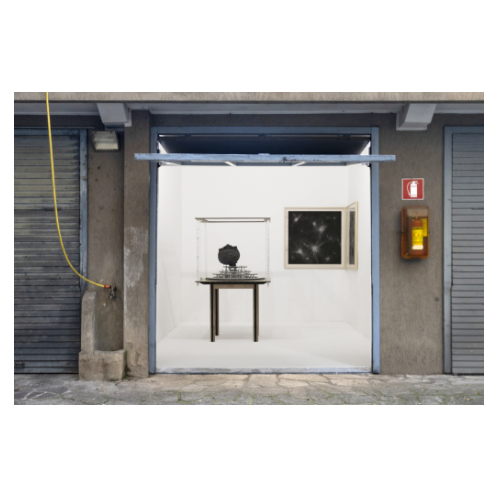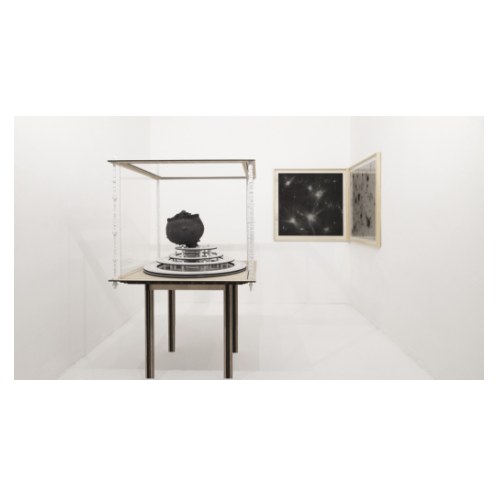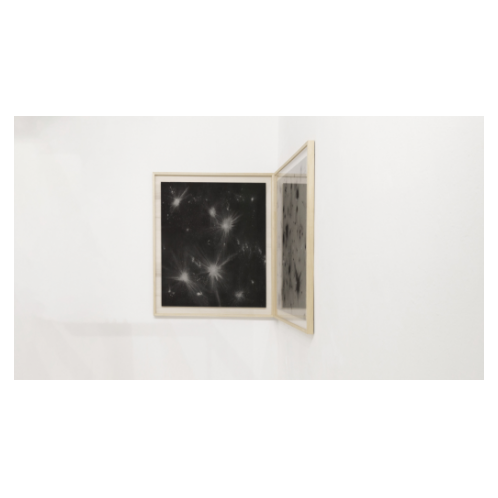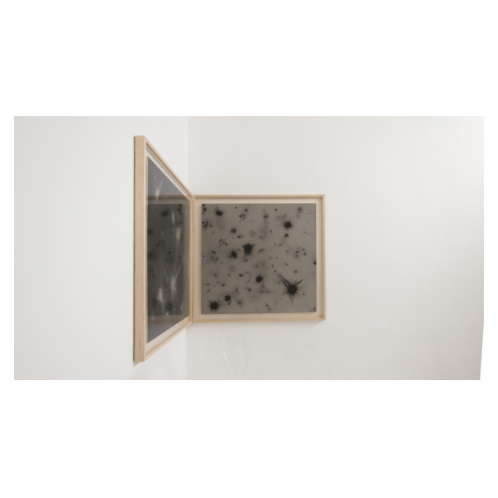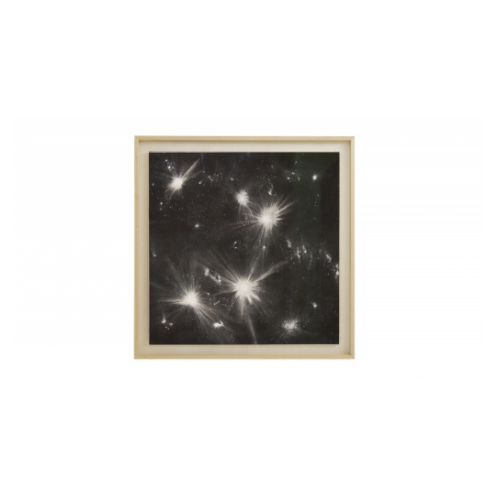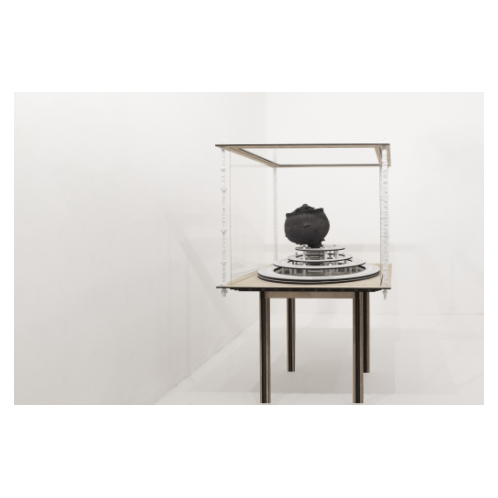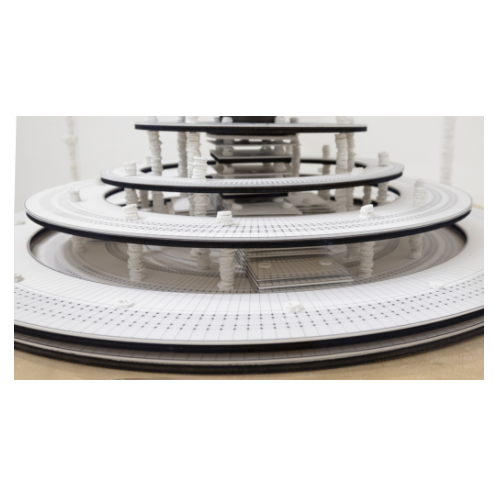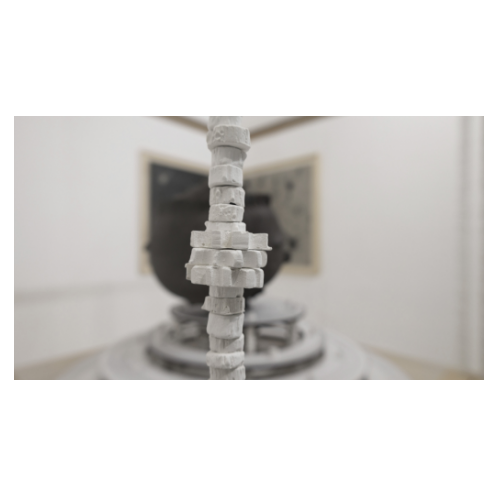Andrea Francolino/Michele Guido
Download Press Release in PDF Format ![]()
ANDREA FRANCOLINO
MICHELE GUIDO
KOSMOS
testo di / text by
GIULIA BORTOLUZZI
INAUGURAZIONE
MARTEDÌ 9 APRILE 2024
ORE 18-21
dal 9 aprile al 25 maggio 2024
solo su appuntamento
“Guardar giù verso me stesso e persino verso le mie stelle: solo questo può voler dire la mia vetta per me, questo mi è ancora rimasto come la mia ultima vetta!”1. Salire così in alto da vedere le stelle al di sotto dei propri piedi, lasciare che lo spirito di gravità attiri la materia verso il basso, continuare a percorrere la lunga via, trovare le cose annodate saldamente l’una all’altra perché ognuna trae con sé quella avvenire, compresa sé stessa.
Si muovono così le polveri di ipotetiche stelle scagliate nello spazio che Andrea Francolino ha messe nel suo metro quadrato (Reverso2, 2024). Due antinomie. Sono infinitamente grandi e infinitamente piccole. Colte nella tensione di un luogo che evidentemente si estende e si espande, sono ordine e disordine, cosmo appunto, un paesaggio di caos e caso, una materia organica e artificiale, che importa? Potrebbero essere stelle, sferoidi che ruotano attorno a un asse. Proprio come la galla nera che Michele Guido ha modellato a partire da una stampa in tre dimensioni seguendo il senso rotatorio del tornio, su tre assi differenti (filanda 05.04.15 _ andricus, quercustozae project _ mausoleo Isaac Newton [Étienne-Louis Boullée], 1784/2023). Come una parassitosi fungina o batterica ha manipolato la malformazione della Quercia trasformandola in un’architettura naturale, peritura quindi, eterna dunque.
In questo proliferare che tende a ritornare in eterno si incontrano piante e minerali, l’insetto opera come un corpo celeste, in basso si trova ciò che è in alto, e la via torna un’altra volta. Si vedono gli astri volgendo gli occhi verso terra, si vedono i vegetali alzando lo sguardo nell’aria. Linee intrecciate e annodate le une alle altre, reticoli che soli resistono al continuo divenire2, la propria genesi non si esaurisce nella produzione ma si forma mentre vive e si sviluppa, intrecciandosi ad altre. Questo cosmo diversamente ordinato è un tempo dove siamo, un universo in ogni punto di osservazione. “Donde vengono le montagne più alte? chiedevo in passato: E allora imparai che esse vengono dal mare”3.
Didascalie:
A. Francolino, Reverso2, 2024. Polvere di cemento recuperato e polvere di terra su Carta Hahnemühle e legno, 2 elementi 115 x 115 cm cad.
M. Guido, filanda 05.04.15 _ andricus quercustozae, project _ mausoleo Isaac Newton (Étienne-Louis Boullée), 1784/2023. Teca: stampa diretta su poliestere bimattato, 75 μ, gesso, multistrato okumè, vetri ar luxar 2mm, acciaio; grès: (manifatture sottosasso – modelleria digitale); 188 x 107 x 107 cm
THE OPEN BOX
Via G.B. Pergolesi 6
MILANO
www.theopenbox.org
info.theopenbox.org@gmail.com
+393382632596
1 F. Nietzsche, Così parlò Zarathustra. Un libro per tutti e per nessuno, [1883-1885] trad. it., M. Montinari, Adelphi, Milano 2007, p. 178.
2 T. Ingold, Siamo Linee. Per un’ecologia delle relazioni sociali, [2015] trad. it., D. Cavallini, Treccani, Roma 2020.
3 F. Nietzsche, Così parlò Zarathustra, cit., p. 179.
ANDREA FRANCOLINO
MICHELE GUIDO
KOSMOS
testo di / text by
GIULIA BORTOLUZZI
OPENING
TUESDAY 9 APRIL 2024
6-9 PM
from 9 April to 25 May 2024
by appointment only
“To look down upon myself, and even upon my stars: that only would I call my summit, that hath remained for me as my last summit!”4 Climbing so high as to see the stars beneath one’s feet, allowing the spirit of gravity to attract matter downwards, continuing to follow the long path, finding things so solidly bound to one another that each draws with it the one to come, including itself.
Thus do the dusts of hypothetical stars move, flung into the space that Andrea Francolino has enclosed in his square metre (Reverso2, 2024). Two antinomies. They are infinitely large and infinitely small. Captured in the tension of a place that evidently extends and expands, they are order and disorder, the cosmos in fact, a landscape of chaos and chance, an organic and artificial material, what difference does it make? They could be stars, spheroids rotating about an axis. Just like the black gall modelled by Michele Guido on the basis of a 3D print following the rotary direction of the lathe, on three different axes (filanda 05.04.15 _ andricus quercustozae, project _ mausoleo Isaac Newton (Étienne-Louis Boullée), 1784/2023). As a fungal or bacterial parasitosis, he has manipulated the oak’s malformation, transforming it into a natural architecture, hence perishable, therefore eternal.
Within this proliferation which tends to return eternally we encounter plants and minerals, the insect works as a celestial body, below remains what is on high, and the path returns once again. We see the stars turning our eyes to the ground, we see the plants raising our gaze into the air. Lines entwining and knotting with one another, meshes that alone resist the continuous becoming5, their genesis is not exhausted by production but forms as it lives and develops, entwining with others. This differently ordered cosmos is a time in which we are, a universe within every point of observation. “When come the highest mountains? So did I once ask. Then did I learn that they come out of the sea.” 6
Captions:
A. Francolino, Reverso2, 2024. Reclaimed cement dust and earth dust on Hahnemühle paper and wood, two elements, each 115 x 115 cm
M. Guido, filanda 05.04.15 _ andricus quercustozae, project _ mausoleo Isaac Newton (Étienne-Louis Boullée), 1784/2023. Case: direct print on matte/matte polyester, 75 μ, plaster, okumè plywood, 2mm ar luxar glass, steel; grès ceramic: (Manifatture Sottosasso – digital modelling); 188 x 107 x 107 cm
THE OPEN BOX
Via G.B. Pergolesi 6
MILANO
www.theopenbox.org
info.theopenbox.org@gmail.com
+393382632596
4 F. Nietzsche, Thus Spake Zarathustra, [1883-1885] trans. T. Common, The Modern Library, New York, 1917, p. 168.
5 T. Ingold, The Life of Lines, Oxon, Routledge, 2015.
6 F. Nietzsche, Thus Spake Zarathustra, cit., p.169.

